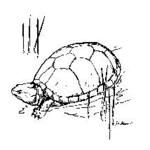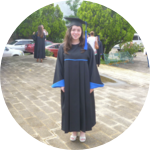Project Results
First we would like to say thank you to all those that supported us. Our results are that the use of mealworms in skeletal preparations is possible. The mean time taken to clean mice skulls was 2.5 days with a standard deviation of 1.70 days. This however gives only some of the picture. After some time working with the mealworms, we saw that some skulls were cleaned in hours and others were cleaned in several days. There was a variable that we did not control for. Based solely on observational data we believe the uncontrolled variable is water availability. When water was available the time to clean a skull increased drastically. While we had hoped to produce a publishable paper out of this project, it appears that we need to redesign our study before further results can be found.
Despite of this the project was a huge success. Four teenage girls designed, implemented, and obtained results as real scientists. There was a true interest in the project and the outcome. At the end of the year there was school wide interest in the outcome of our study. Once again a huge thank you to all those that supported us.
About This Project
Could Mealworms be used as an alternative to dermestid beetles for skeleton preparation? In museums, dermestid beetles can cause infestation problems and destruction of valuable collections if let loose. Through this experiment, we would like to find a way to reduce the chances of museum infestations and give amateur osteologists and hunters an easier way of processing animal materials to get clean skeletons.
Ask the Scientists
Join The DiscussionWhat is the context of this research?
For years, museums have used dermestid beetles to remove residual tissue from skeletal preparations. The way in which these beatles eat the soft tissue resembles natural decomposition and is less damaging to small bones. However, these beetles can also become a hazard to museums, since they can consume skin collections and other museum displays.
There are chemical alternatives to the process of skeleton preparation, but they often leave skeletons weak and prone to breakage. We would like to find a way to limit the chance of infestation while creating a strong and long lasting skeletal display.
What is the significance of this project?
In 1950, a research study by E. Ross Allen and Wilfred T. Neil proposed Mealworms as an alternative to dermestid beetles for skull preparation because of these advantages: they are easy to get, require little care, can be kept in any contianer, and won't spread to infest valuable collections.
This research wasn't exhaustive and no published experimentation has been done since. We want to test their proposal and find out if mealworms can be used to remove flesh from osteological collections. If we find that they can be used for skeleton preparation, the method could be used by museums, hunters, and scientists all over the world as a safer easier alternative to dermestid beetles and chemical solutions.
What are the goals of the project?
The goal of this experiment is to find out if Mealworms can be used to prepare skeletal remains and determine the rate at which they can clean mammal skulls. We will do a pilot study to determine the number of mealworms needed to clean a mouse skull and the estimated rate of tissue removal per 1,000 mealworms. We will use 10 skulls.
The study will be done using 4000 Mealworms in a container. We will place a weighed skinned and defleshed mouse skull in the substrate. When it is clean it will be removed and weighed again. We will use the initial weight and clean weight to determine the rate of removal of flesh.
Budget
For this project we're going to use several thousand mealworms to clean out the skulls of 40 frozen mice. Other materials that we will need to carry out the experiment are dissection trays and kits, scalple blades, and a scale to determine how efficient mealworms are at removing residual tissue from the skull.
Endorsed by
 Project Timeline
Project Timeline
We will start by doing the skull preparations. We will then do a pilot study to confirm the findings of Allen and Neill 1950. The only scientific citation of using Mealworms in skull preparations. After doing our pilot experiment, we will collect the data for our study and we will end by writing a scientific paper outlining our findings.
Oct 30, 2017
Project Launched
Nov 03, 2017
Skull preparation
Nov 10, 2017
Pilot experiment
Dec 08, 2017
Data collection
Feb 16, 2018
Completion of scientific paper
Meet the Team
Team Bio
We are the Green Council at the International Institute in Chapala, Jalisco, México. We are students from Junior High and High School that are interested in science, sustainability, and socializing! We hope to make an impact and get into the best colleges and universities around the world.
Matthew R Pettus
I am an experienced educator and scientist with 10 years teaching experience. I work at the Instituto Internacional and I currently teach IB Biology and Green Council.
I am a recent transplant to Mexico and I have enjoyed learning Spanish, and experiencing the culture of Mexico. I have interests in educational leadership, best practices in IB education, and bring real life research in to the classroom.
Mariana Gómez
I am a High School Senior at the International Institute in Chapala, México. I'm studying the IB Diploma Programme.
I have always been interested in caring for the environment and I am going to study Environmental Engineering when I graduate.
Tatiana Orozco
I am 16 years old and mexican. I like everything related to ecology. I play volleyball, and I l like painting, editing videos, traveling, and cooking desserts.
I am a 10th grade student at the International Institute in Chapala, México.
Abril Orozco Partida
My name is Abril. I am 13 years old and I am an 8th grade student. I like to bake and I am part of the Green Council at the International Institute in Chapala, Jalisco, México.
Tamara Lizeth Dueñas Ponce
My name is Tamara Lizeth Dueñas Ponce. I'm in my second year of Junior High School at the International Institute. I am 13 years old, and I really like technology, cooking, gardening, and swimming.
Project Backers
- 25Backers
- 100%Funded
- $603Total Donations
- $24.12Average Donation








